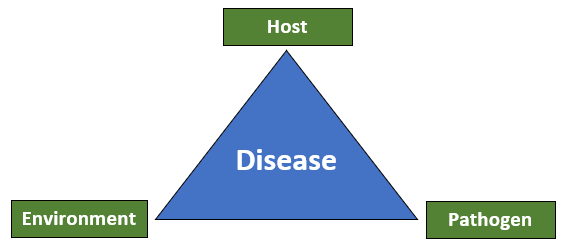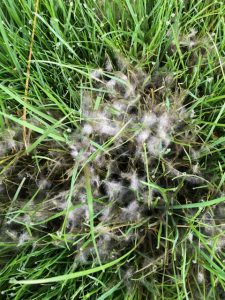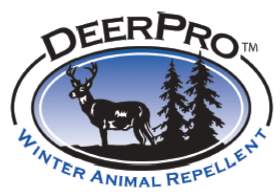Category Archives: Lawn Diseases
What Causes Lawn Disease?
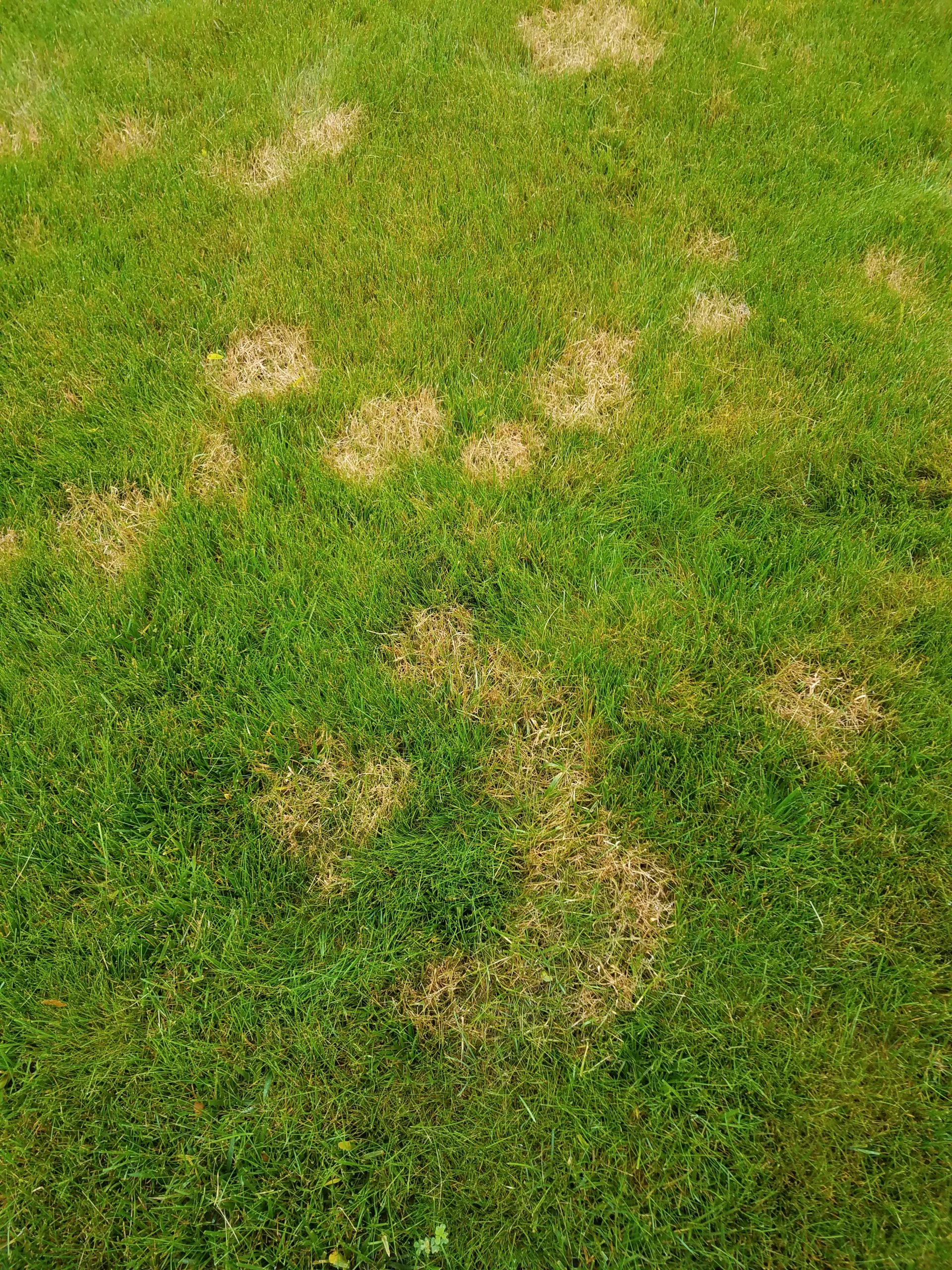
Each year homeowners call about areas of their lawn turning brown or dying and want us to come evaluate the problem. There are several different things that could be causing the issue; however, disease is the most questioned and misunderstood diagnosis. What causes lawn disease? The environment is the biggest factor in why your lawn gets disease. In this blog, we are going to dive in a little deeper and help you understand exactly which environmental conditions are to blame.
Before we get into the different environmental conditions, let’s first discuss how plants get infected. The disease triangle below is not just for turf, but all plants susceptible to disease.
All three corners of the disease triangle must be present for the disease to occur. The host is a plant susceptible to disease. The pathogen is typically a fungus for most lawn diseases. The environment refers to the conditions that a specific disease needs to enter a plant.
The Host
For turf, defining the host is easy, it’s the types of grass varieties you have on the property. All grass varieties are different, and some are more susceptible to certain diseases than others. Knowing the grass variety will help you narrow down the list of potential diseases you need to be on the lookout for.
New grass varieties are constantly being developed that are marketed as more resistant to disease. We will touch on using these new varieties later in the blog, but it’s important to note that these varieties are resistant, NOT IMMUNE, so disease can still infect the plant. The same holds true for resistant trees and shrubs, just because they are resistant, does not mean those trees and shrubs will never get disease.
The Pathogen
The pathogens that cause lawn disease are typically fungus but can also be bacteria or virus. The fungus needs to be present in the soil, it gets there by creating spores that get moved by wind or are carried over by animals. Pathogen presence is not in our control, so for this blog we will just assume the pathogens are in the soil.
The Environment
The environment is the final corner of the disease triangle and the most critical. There are certain practices we can follow to minimize environmental impacts. For turf, fungal pathogens can enter the plant when two conditions are present. The first is temperature, most fungal pathogens prefer warmer weather, above 70 degrees Fahrenheit during the day, but more critical are temperatures at night. Depending on the actual fungus, most need nighttime temperatures to be above 55 degrees. The second condition is moisture, pathogens can enter the host when the leaf tissue is wet. This means your lawn is most susceptible to disease when the nighttime temperatures are high and it’s raining or very humid. We can’t control the weather, so if we get the right environmental conditions, disease can become an issue. The past two seasons in New Jersey were not typical with respect to the large amounts of rainfall we received, especially during the late summer and early fall months. Both years we also saw a large spike in disease activity, not only on home lawns but on sports fields and golf courses as well.
What Can We Do?
So, if I can’t control the weather, the pathogen is already in my soil, and the host is susceptible, is there anything I can do? Absolutely! Let’s start by looking at the moisture portion of the environment. This is very important, especially if you have irrigation. If the temperatures at night are above 55 degrees and you have your irrigation set to water every single day for 30 minutes, you are creating the perfect environment for disease by getting the leaf tissue wet every day! Watering correctly is critical, especially when the temperatures are ideal for disease. You want to water infrequently, between the hours of 12am and 6am are ideal because the grass is already wet from dew formation. A good starting point is to water your lawn only twice per week at approximately 1 hour per zone between 12am and 6am. This only a starting point and will change depending on the weather, for more detailed watering instructions click here for a blog on proper watering schedules.
Still focusing on moisture, we need to look at a few other things. Is your soil compacted? If so, the water will remain on the surface, taking longer to drain into the ground. Improve drainage by aerating your lawn at least every other year or even more often if it’s severely compacted. Grading also plays a role, lower sections of turf will retain moisture longer, making it more likely for a pathogen to enter and infect those plants. Have a landscaper improve the grading to get even run off and minimize the pooling of water in low areas.
Seeding
Hopefully by now, you understand how the environment plays a key role in causing lawn disease, especially moisture! If you have addressed the moisture issues above and disease is still an issue, another option to try is overseeding with a newer variety of turf. You’ll want to pick a variety that is more disease resistant and made for the environment you are seeding (sun seed in the sun, shade seed in the shade). Plants that are already under stress are more likely to get infected by a pathogen than those that are healthy. This means that your shade loving grass variety planted in the full sun will be really stressed out in the summer heat and more likely to get disease each year. Use seed that is right for the environment you are planting in, try to avoid the generic “Sun and shade mixes” if possible. Remember, disease resistance does not mean immune!
Chemical Control
Another option for battling disease is chemical control with a fungicide. Some diseases attack the roots, by the time you see the impacts on the surface, it is too late to treat, and preventative control should be considered in the future. Other diseases can be treated, most foliar diseases can be stopped for approximately 30 days with a fungicide. A very common question with fungicides is “Is this it, or will I need another fungicide?” The answer to that all depends on…yup you guessed it, the weather! After 30 days, if the lows at night are above 55 degrees and its very humid or rainy, then the disease could become active again.
One of the main barriers to applying fungicides is cost. Fungicides are some of the most expensive products in the lawn care industry. If you have zero tolerance for disease in your lawn, then monthly preventative fungicide treatments in the late spring and summer is the way to go, but it’s not cheap. Another option is to hold off until the forecast shows favorable disease conditions. At that point you can have a fungicide applied to protect the turf for 30 days. The final option is to treat the disease after it has already infected the plant. This will stop the disease from spreading for approximately 30 days and it’s important to treat it as soon as possible. The longer it’s active, the less likely it is for the infected plants to recover. Waiting to treat after the plant is infected is not always an option, for some diseases it’s either too late or no products exist to effectively stop the spread. Your lawn care provider can diagnose the disease and let you know what options are available. You can also have a sample of your turf tested to confirm disease is the culprit.
Conclusion
Hopefully, you have a better understanding of what causes lawn disease after reading this blog post. If you’re in our service area and have questions about disease, or anything lawn care related, please give our office a call at 908-281-7888.
Minimizing Disease Activity: Cultural Practice and Fungicides
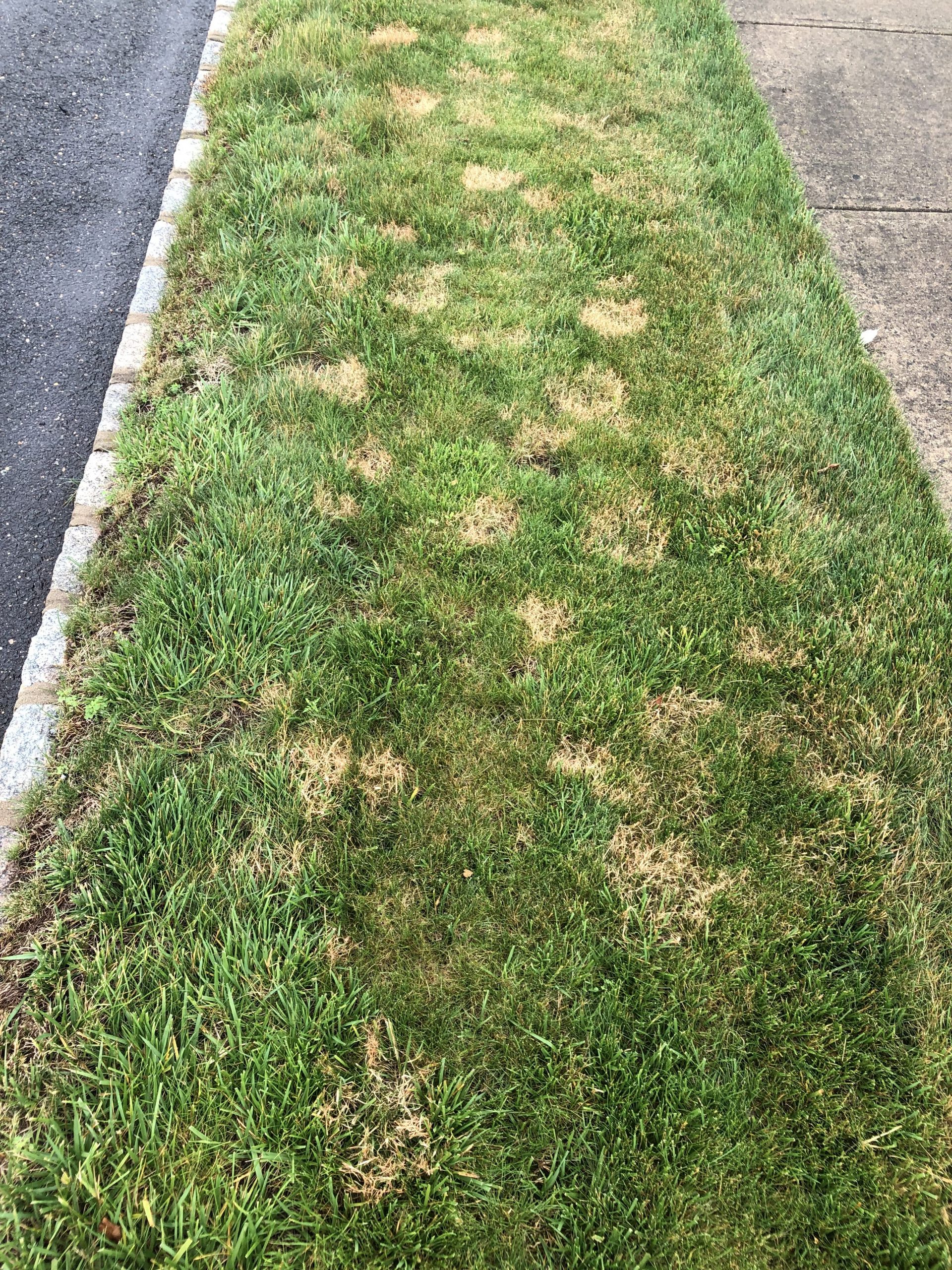
The grass on your property is sometimes easy to dismiss as just ground cover, or a playing surface, or even some sort of given amenity that comes with the purchase of a home. However, the reality is that the lawn is a living thing; and not only that, it is an entire population of living things. In fact, when considering the soil environment it inhabits, it is an entire ecosystem with millions of living organisms. Among the myriad of organisms that dwell under our feet disease pathogens reside. When conditions are favorable, microbial fungi populations cause lawn disease outbreak. This is when a lawn breaks out in disease activity.
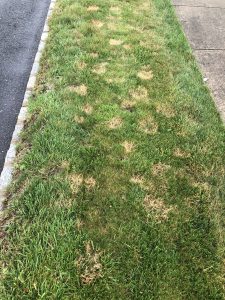
First, it is important to realize that the only plants affected by lawn diseases are desirable grass species, the same grass we spend a lot of time and money trying to maintain. Weeds such as dandelions, clover and crabgrass are not adversely affected by lawn diseases. Lawns without fertilization or irrigation are also much less likely to exhibit any issues with lawn disease. This is discouraging, because it means that only the lawns that are kept weed free, well-fed, and watered are the ones that can contract significant disease, while a not maintained lawn dodge this bullet altogether.
So, what does this mean? We should not try to maintain high quality lawns? Of course not, it just means that if you are going to have a premium lawn, you should consider the potential for disease activity.
Infections occur in lawns when the activity of the disease-causing fungi is higher than the activity of the lawn growth. The best defense against disease outbreak is creating an environment within the lawn that favors growth of turf and discourages fungal activity. Creating a favorable turf growth environment and a healthy soil ecosystem all happens through the initiation of good cultural practice techniques.
Core Aeration
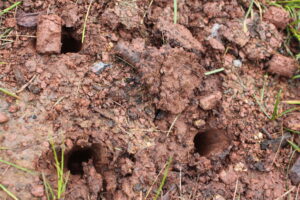
This photo demonstrates what core aeration plugs look like in the soil.
It pretty much goes without saying that human beings are wildly fond of oxygen. What you might not realize is that plants love this stuff just as much as we do because plant roots need oxygen to thrive. The problem is the oxygen is up here and the roots are buried, and in New Jersey they are buried in what is often compacted clay soil. Lawns grown in soil with high clay content need to be core aerated at least every-other-year if not annually in order to keep the micro pores at the soil surface open so that the soil remains as oxygenated as possible. This is super important in terms of the battle against lawn disease activity because not only does the grass love the oxygen, the pathogenic fungi hate it. Fungi that cause lawn disease thrives in low oxygen environments, so lawns with compacted soil are far more likely to suffer from disease than those aerated regularly.
Irrigation
Irrigating the lawn can be the most beneficial cultural practice in trying to promote a healthy lawn, or it’s the most serious detriment when done improperly. Plants need water just like we need water, but as previously mentioned plants also need oxygen. Whenever an environment has too much water and not enough available oxygen, plants (just like people) can potentially drown. This is the problem that can be brought on by improper irrigation. Clay soil, that we have in New Jersey, holds water very well, and it takes a while (usually a few days) for water to percolate down through the root zone of the lawn. If ample time is not given between irrigation cycles for the water to move out of the upper few inches of soil, the roots never have a chance to breath in any of the oxygen from the surface. This causes plant roots to become weak and promotes the low oxygen soil environment that the pathogens love. It is critical that when the lawn is irrigated it is done so deeply but not often, maybe once every third or fourth day. And if there are areas of the lawn that hold water longer than others due to partial shade or lower spots, they may require even less frequent irrigation. As a rule, no water should be added until whatever previous water introduced has had a chance to work its way deeper into the soil; this is typically a couple days, however largely depends on the weather.
Seeding
One of the most important cultural practices overlooked in the fight against lawn disease is seeding. Lawns that have been established for a long time probably have grass that is of lesser quality than more recently developed grass varieties. Turfgrass scientists are always hard at work trying to cross-breed new varieties of grass that are less susceptible to drought stress, traffic stress, insects and disease. Re-doing portions of the lawn with newer turf varieties can provide a lawn that is able to help itself a bit more and create a lower maintenance situation.
The Implications of Weather
Sometimes despite the best efforts to provide the most beneficial turf environment, a force much more powerful than human cultural practice can step in and create a very favorable disease environment…the weather. Periods of stressful, dry heat followed by rain or vice versa can cause full blown disease epidemics. When this happens, the best thing to do is call a professional lawn care service to have the lawn evaluated. A good lawn service agent should be able to not only diagnose the lawn disease correctly, but also consider all the conditions at a particular property and decide what the best course of action should be.
Fungicides
One of the things a professional may recommend as part of an action plan in response to lawn disease outbreak is applying a fungicide. Fungicides are very much like medicine for the disease. Once applied, fungicides keep the lawn disease activity down for anywhere between 2-4 weeks, which allows the lawn time enough to grow out the infected leaf tissue. What is important to realize when using fungicides is that they are not a cure. These treatments simply provide a window of disease inactivity, so that professionals and/or homeowners can promote the growth and recovery of the turf. It is also important to understand that while these products can be very effective, they are not always the answer. Like medicine, fungicides are expensive, so they are not going to be part of a professional recommendation unless the service provider is sure they are effective. You do not administer medicine after a sickness has run its course, do you? Similarly, a lawn care professional does not recommend a fungicide if the lawn disease would be subsiding naturally due to changes in weather, among other reasons.
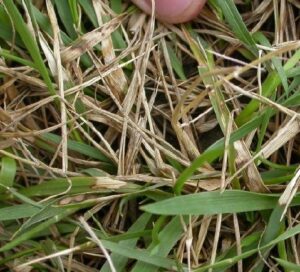
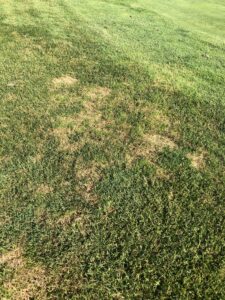
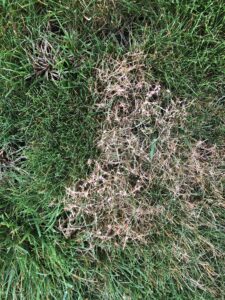
Fungicides can also serve as part of lawn disease prevention. Just like your doctor may prescribe medicine to take daily along with the right diet and exercise to thwart illness, in some cases a professional may decide that a regimen of fungicides added to the annual maintenance program to keep out lawn disease. A preventative fungicide program consists of several applications done periodically when the lawn disease targeted is most likely to occur. The timing and number of applications can vary a great deal depending on the disease you are aiming to controlled, the products used, and the budget allocated for the lawn. Again, fungicides are expensive and only work for 2-4 weeks at a time, so adding this type of service to the annual maintenance expense is not for everyone. Therefore, they are not included as part of any “standard” professional lawn maintenance plan offered to homeowners. While they are part of a standard golf course or sports turf regimen, preventative fungicide programs are generally reserved (if even offered at all) for only those residential properties where there is a documented history of disease year after year.
Conclusion
In the end, maintaining the long-term health of the soil and the grass through good cultural practice is always beneficial. After all, lawn diseases aren’t the only problems a lawn can face each year and keeping the lawn healthy always insures that it is more likely to recover from any number of issues. If serious disease outbreak occurs, or the lawn develops chronic issues with disease, a complete consultation with a knowledgeable lawn care professional may provide all the answers you’re looking for.
If you are in our service area, and have questions regarding disease activity on your property, you can request an estimate, or give our office a call at 908-281-7888.
Brown Patch Lawn Disease
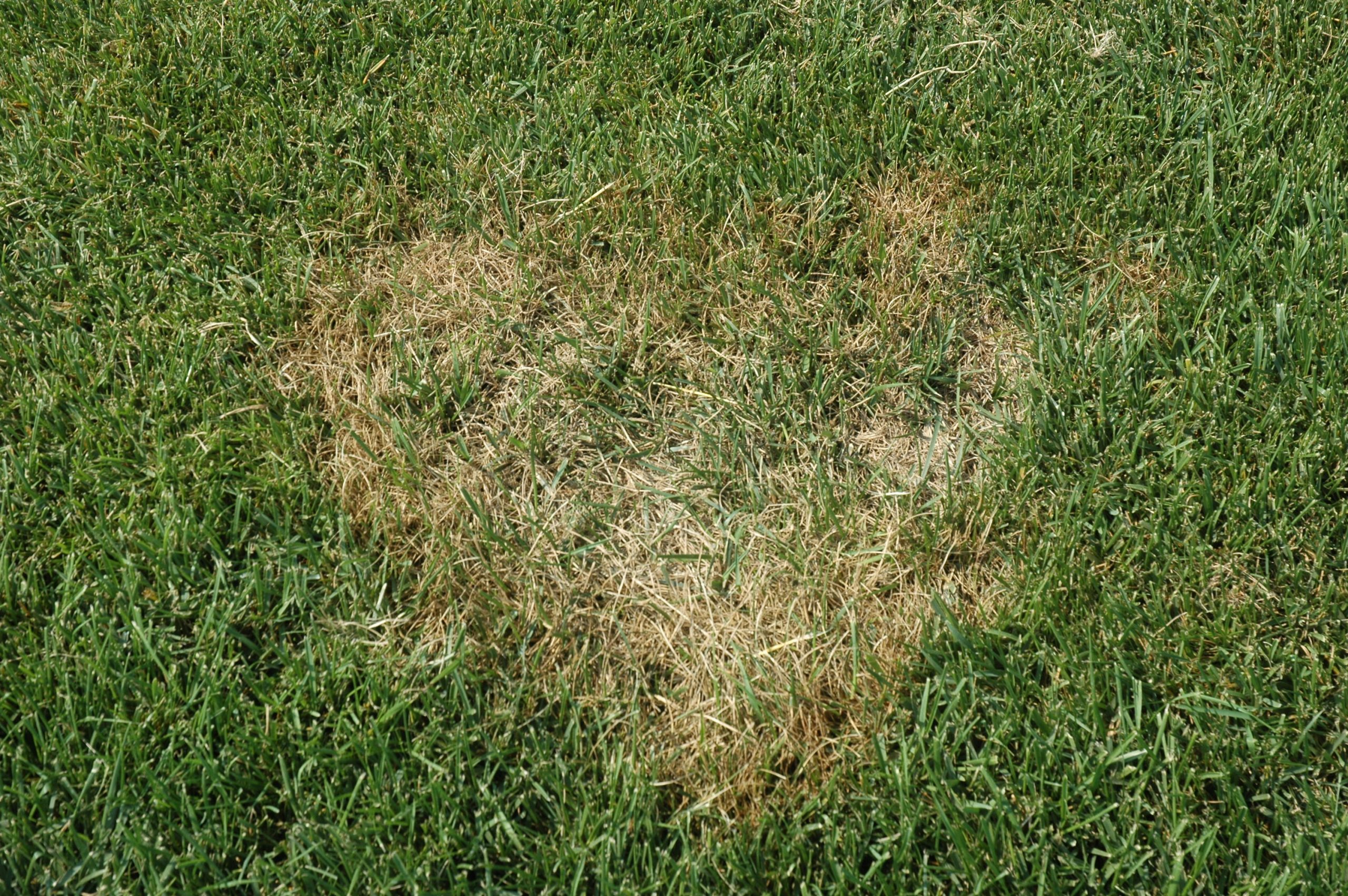
There are several different lawn diseases that plague nearly all the desirable turf species in our area. One of the most frustrating and damaging of these is caused by the dreaded pathogen rhizoctonia solani, or what we commonly refer to as brown patch. This microscopic menace can survive embedded in plant tissue or on the surface of the soil. Found nearly everywhere, the pathogen can lie in wait for extensive periods of time, even in the absence of a suitable host, just waiting for the conditions to become favorable.
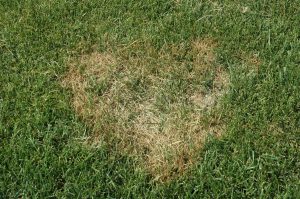
When is brown patch active?
You can expect this uninvited guest anytime during the summer months. Brown patch activity begins as soon as the weather becomes hot and humid, and especially when such conditions persist through the night. The speed with which this disease starts to matriculate into residential lawns is what frustrates homeowners and lawncare operators most. Brown patch can severely blight large portions of turfgrass inside of a 6 to 8-hour period when conditions are favorable. This means you can literally wake up one morning to see large patches of discolored, wilted turf!
Turf Symptoms
In researching symptoms of this disease on the internet, this conjures a lot of images of how brown patch appears on the golf course. On low cut turf, maintained at the highest levels of fertility, halos of dark gray “smoke rings” appear on the turf making the diagnosis a no brainer. On residential lawns however, the turf kept at a 2”-3” height under moderate levels of fertility, the damage is far subtler.
The thread-like mycelium of brown patch is present in the morning dew and look very much like cob webs. These cob web structures disappear however, once the surface moisture evaporates. The damage to the turf appears as more or less circular shaped areas of tan to brown colored grass. The plants become wilted, giving the patches a sunken look to them, almost as though they have been pressed into the lawn by a strange, oversized stamp. These damaged patches can coalesce into larger areas of discolored turf as the disease continues to spread, and eventually cause thinning of the turf that requires seeding at the end of summer to repair. If there is any additional stress on the property from drought, machine traffic, insects, etc., the damage can be more extensive.
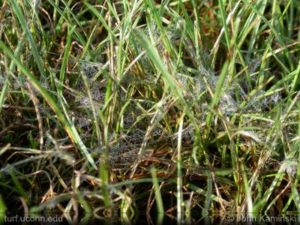
A close up look at brown patch mycelium
Cultural Practices in Minimizing Brown Patch
Since conditions that allow for extensive periods of leaf moisture promote this disease, especially in the overnight hours, it is critical that homeowners not create such conditions with improper irrigation. Whether using hose-end sprinklers or an in-ground irrigation system to water the lawn, the goal is always the same. Ideally, water the lawn heavily between 12am-6am so that the water penetrates the soil while the sun is not out, and any excess evaporates from the surface immediately following.
Also, give the lawn enough time in between watering, usually about 3 to 4 days, for the moisture to make its way down into the root zone before adding more water. This allows the soil surface to dry out so that oxygen can enter the pore spaces. If you water the lawn in the evening the surface remains wet from then until dawn, or you water too frequently, and the roots never can take in oxygen, this creates conditions that are perfect for brown patch. Deep, infrequent watering is the best way to prevent severe brown patch outbreak.
Low oxygen soil in general promotes brown patch activity, therefore allowing the soil to become overly compacted can also be a catalyst. Maintaining porous soil, that is as oxygenated as possible, is the best long-term cultural deterrent against brown patch. The best way to achieve this type of soil structure is with regular core aeration. Soil such as ours here in New Jersey, that is high in clay, needs to be core aerated at least every other year to maintain good structure. Annual core aeration would especially be advisable on properties with a history of frequent disease.
Brown Patch Fungicide Treatments
If brown patch outbreak does occur quickly, you should call your lawn care provider to schedule a fungicide treatment as soon as possible. If outbreaks are left unchecked, brown patch can damage the turf to the point where re-seeding becomes necessary. A timely fungicide application completed when symptoms start to appear can render the disease inactive for a few weeks. This gives the homeowner time to promote new growth through proper irrigation, so that infected portions of the grass can grow out and mowed off. It is important to point out that fungicides are not a “cure”, they are more like medicine we use when we get sick. They control the symptoms so that the patient (in this case the lawn) can fight the infection by taking care of themselves.
When we get a cold, it is bed rest and fluids that cure us from the illness, not the cough syrup. In the case of the lawn, it is making sure it has adequate soil moisture and oxygen.
Conclusion
In the end, as with almost all diseases, the better cultural care you provide for your lawn, the less likely any serious brown patch activity can arise. The more you water the lawn properly and core aerate regularly, the more equipped the turf is to fend off the barrage of fungi activity out there. Should your lawn quality start to suffer at the hands of this disease despite your best efforts, there are fungicides that can be utilized to relieve the symptoms so that the grass can be nursed back to health.
If you are located in our service area, and have questions regarding disease activity on your lawn, please give our office a call or request and estimate.
Ascochyta Leaf Blight
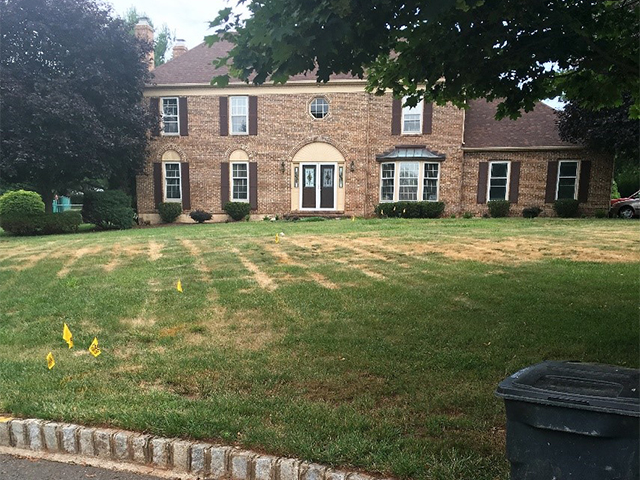
Lawn disease can affect any lawn at any time; regardless of having a professional lawn care company or, if you are a do-it-yourself, lawn diseases can and will happen. A disease in a lawn can occur when a host (grass), a pathogen (fungi) and ideal environmental conditions are present. These conditions include but are not limited to day time and night time air temperatures, moisture, rain, sunlight, lack of sunlight, and improper watering and mowing. Once these factors, although different for each disease, are met the disease can start up. If the environmental conditions remain favorable a disease can persist for extended periods of time. The longer a disease remains active the more damage it can potentially do to the turf. Fungi can remain dormant in the soil for years until the correct environmental conditions that favor a specific disease before an outbreak occurs. Lawn diseases can be distributed by wind, rain, foot traffic, lawn mowing equipment, etc. Common for the late spring, ascochyta leaf blight can greatly impact the look of the lawn.
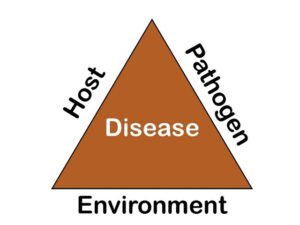
What is Ascochyta Leaf Blight
Ascochyta leaf blight is a common foliar disease that occurs in the late spring to early summer. This disease is more common during hot, dry periods and followed by cool and rainy conditions. The symptoms of ascochyta leaf blight appear as large irregular patches of turf that rapidly turn a straw-color and appear to be dead. From a distance the straw-colored areas resemble drought stress. The infected leaf blades appear to be sucked in from the tip down. While this disease looks very serious when outbreaks are widespread, it is actually quite harmless. This disease will not cause any permanent injury to the lawn. This disease will spread very fast by foot traffic, rain, and lawn mowing. Often times, mowing machines pick up the fungus and spreads the disease throughout the lawn, creating a stripe like pattern of the disease in the lawn. Cultural practices are the only way to help get rid of the disease.

This picture illustrates how ascochyta leaf blight can be spread from a mower.
What kind of grass does it effect?
Kentucky bluegrass is the most susceptible to ascochyta leaf blight; however tall fescue and perennial ryegrass types are also vulnerable to the lawn disease.
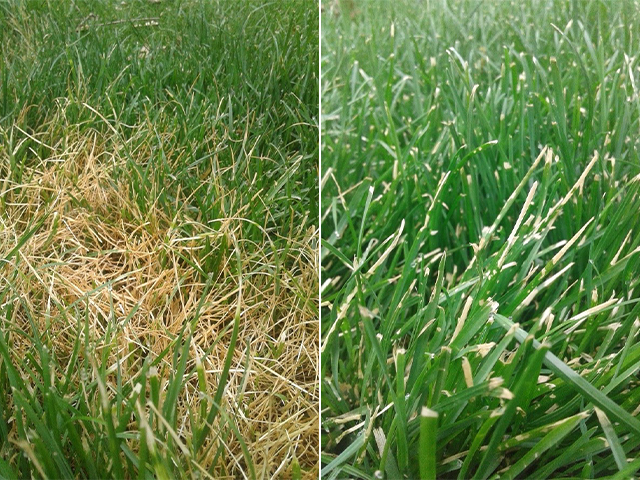
Cultural management
Watering properly is key to controlling ascochyta leaf blight. Avoid light, frequent irrigation in the early morning while surface moisture is present. Deep, infrequent watering that occurs between 12 am – 6 am and we recommend to water 1 – 1 ½ hours per zone every third or fourth day is best. For more information about watering your lawn, check out our blog.
Proper mowing also helps. Do not mow in the morning when the lawn is wet from the dew or last night’s scheduled watering. This will spread the disease further. Mow the lawn in the afternoon when the surface moisture has evaporated. Keep the lawn height at 3 – 3 ½ inches in length. Mow off 1/3 off the grass plant at a time.
Fertilize regularly to help stimulate growth of the grass. The faster the grass is growing the faster the disease will get grown out of the lawn on its own.
Core Aerate the lawn regularly in the early fall to help reduce thatch (where disease harbors) soil compaction. This will also help to create a stronger root system and grass plants.
Unfortunately, fungicide treatments are not available for this particular disease.
Conclusion
It is important to remember that ascochyta blight will not kill your lawn. It simply needs to grow out on its own with a little help from you, the homeowner. If the conditions remain favorable this type of disease can persist for weeks. After all cultural practices have been done, the only other thing you can do is be patient. Give it time, your lawn will be okay.
If you have any questions about ascochyta leaf blight and you are in our service area, please give our office a call at 908-281-7888 or request an estimate.
Red Thread Lawn Disease
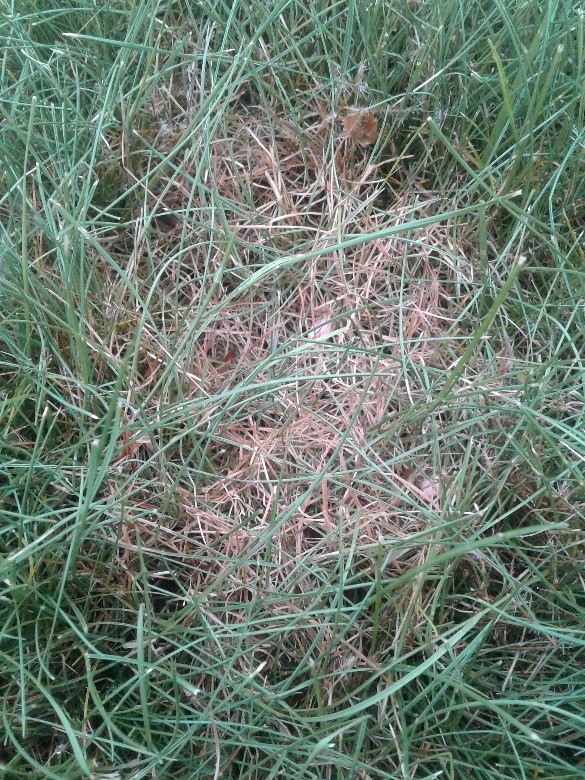

A closeup of red thread lawn disease.
Lawn diseases are frustrating for every homeowner that desires to maintain the picture-perfect lawn and landscape. Unfortunately, the warmer temperatures of the spring-time that we all love; along with frequent rainy periods, creates the perfect storm of environmental conditions to be just right for fungus to grow in the lawn. A frequent spring-time lawn disease observed in many lawns is Red Thread Disease.
What is Red Thread Disease?
Red Thread Disease is caused by the fungus Laetisaria fuciformis, and is most notable during the early spring months. The first observable symptoms of red thread lawn disease are tan-to-red thread like growths called sclerotia, often seen in patches of 4 to 6 inches in diameter. Two environmental conditions that are key components to the fungus growing are high levels of humidity and temperatures between 60 to 75; making the spring time optimal for the disease to spread. The sclerotia strands can protrude upward from the blade tip of the grass, making them noticeable among other patches of disease free, green grass.
What kind of grass does it effect?
Although all varieties of turf grass are susceptible to red thread lawn disease; perennial ryegrass has been found to be the most susceptible, and fine fescues are also especially susceptible.
Cultural Management
Although the disease is unsightly, red thread lawn disease does not cause permanent injury to the grass. The key to controlling red thread lawn disease culturally is to promote turf growth. Maintaining adequate nitrogen and good soil moisture are the two most important factors when dealing with a red thread outbreak. This will not only help to grow out the disease but, also creates a stronger healthier lawn overall. As the new growth occurs, the disease portions are cut away, leaving the healthy turf underneath exposed.
When red thread lawn disease has been a persistent issue, checking the soil pH level and maintaining a reading between 6.3 and 6.7 may help in reducing the issue. Also, the sclerotia survives in the thatch layer of the lawn. Heavy thatch build up and soil compaction can be reduced by core aeration, and we recommend this procedure is performed biennially in the late summer or early fall.
Additionally, it is important to practice watering techniques that will not overwater your lawn since the disease thrives under moist conditions. We recommend watering between midnight to 6 am and for those that have underground irrigation systems, run each zone for 1 hour twice a week. For traditional hose end sprinklers, run the sprinkler for 4 hours per area of coverage twice a week. For more information about watering your lawn, check out our blog.
If optimal weather conditions persist for this fungus, it will continue to spread more rapidly than the grass can grow it off. In this case, it may take several weeks to over a month for complete recovery of the turf.
Treatment for Red Thread lawn disease
While this fungus will not kill the lawn, it can be frustrating for homeowners to deal with this eye sore for weeks while it grows out. If red thread lawn disease is severe, a fungicide treatment can be applied to the lawn. Post application, the disease will not be able to actively spread for three to four weeks. This allows the lawn time to grow out the infected grass blades more quickly than the disease can spread, and the fungus is gradually cut away with regular mowing.
Conclusion
Red thread lawn disease is common; luckily it does not cause permanent damage on your lawn. Most red thread outbreaks can be kept under control through sound cultural practice, and the lawn can soon return to the green state it was prior. For especially bad cases, fungicide treatment is available to control the red thread lawn disease. If you have any questions about treating red thread lawn disease and you are in our service area, please give our office a call at 908-281-7888 or request an estimate.
Snow Mold Disease
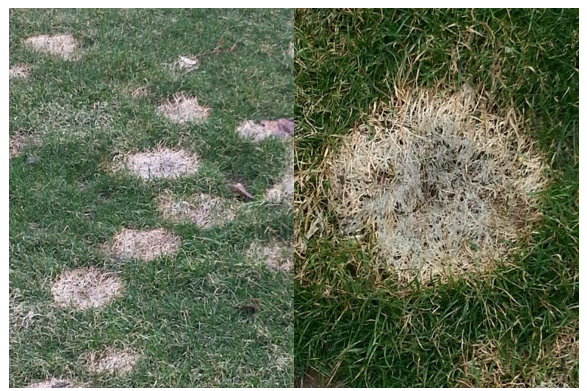
After a snow storm your yard looks pretty and picturesque, like a Bob Ross landscape painting! But underneath this serene scene there is a lot going on with your grass; including dreaded diseases! Snow mold is a fungal disease that can become active on turf under the cover of snow in the early spring. There are two types of snow molds common in New Jersey; pink snow mold and gray snow mold.

Above are two examples of what snow mold can look like on your lawn.
Pink Snow Mold
Once the snow starts to melt, pink snow mold disease becomes evident. Pink snow mold gets its name from the pink fungal spores that collect on the grass leaf. These spots will start out straw colored and the accumulation of spores on the grass leaf can become so numerous it starts to produce pink circular spots in the lawn that have a matted down appearance. The spots can grow to five inches in diameter and have a bronze border. When there are multiple spots, they can coalesce into larger irregular areas in the lawn.
Pink snow mold disease can continue during wet weather if the temperatures are between 35° F and 65° F, with an optimal temperature at 45° F. Pink snow mold does not only occur under heavy snow, the activity also occurs in light rains, heavy dew, overcast skies, fog and most importantly, extended leaf wetness. It can take from forty-eight hours up to seventy-two hours for this disease to start to form.
Gray Snow Mold
Gray snow mold disease is similar to pink snow mold discussed above, but with a few different distinctions. First being the color of the disease. The patches will start out as a straw-colored spot then turn gray or silver in color. The patches can range from several inches to large swaths of turf. This disease can live in the thatch layer, the crown and/or the leaves of the grass plant over the summer time. Secondly, gray snow mold only occurs under snow cover, while pink snow mold can occur with or without snow cover. In most cases this disease kills the blade of the grass and not the crowns or roots.
Gray snow mold occurs between 35° F to 50° F with an optimal temperature of 35° F. Heavy thatch can also play a key role in the formation of gray snow mold disease. Other factors that can contribute to this disease are light rains, heavy dew on the turf, overcast skies, fog and extended leaf wetness.
Cultural Practices
Pink and gray are the most common of the snow molds and with both types of snow molds, the key factor that starts these diseases, is that snow covers the ground before the soil freezes.
Both diseases can be managed successfully at home with simple cultural practices.
- Maintain adequate fertility levels in the lawn. A soil test can be done to see which nutrients levels need to be adjusted in the soil.
- During the season, water your lawn correctly. Try to avoid moisture stress (drought) and water at the optimal times of day. We recommend watering for 1 – 1 ½ hours per zone twice per week between midnight to 6 A.M.
- Mow into the late fall (as long as the grass is currently growing) at proper mowing heights by keeping the grass blades at 3 – 3 ½ inches in length. If the grass is too tall going into dormancy, the matted down grass can encourage snow mold disease.
- Core aerate the lawn in the fall. This process not only reduces the thatch layer, where these diseases can harbor, but is also beneficial to the lawn in so many other ways (see our core aeration blog for more information).
- After a snowfall try to not pile up too much snow in one area. The longer the grass is under the snow the more time it receives zero sunlight and oxygen.
- After the snow is melted and you can see the matted down spots, use a light plastic leaf rake to break the crusty matted down grass and gently “fluff” up the areas with the rake. This will improve air flow and growth.
Conclusion
Winter is a harsh time of year and lawns that are infected with either type of snow mold disease are generally late to green up. The damage caused by snow mold is not usually serious. Applying fungicides in the spring after the symptoms of snow mold appear is of no value and will not help. But patience and a little bit of TLC goes a long way. If you are in our service area and have any questions about topics of snow mold disease, please give our office a call at 908-281-7888.
Treating Summer Patch and Dollar Spot in the Summer Months
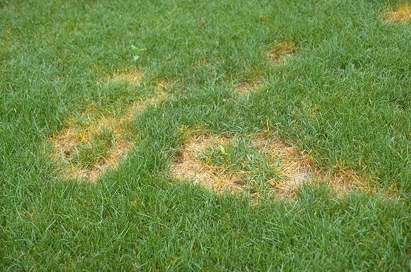
There are many diseases during the summer that can cause significant damage to lawns in New Jersey. The impact of these diseases can produce devastating effects and costly repairs to your lawn.
Summer Patch

One of the worst diseases is summer patch disease. Summer patch is a root disease that primarily affects Kentucky bluegrass; it can also cause damage to creeping red fescues and hard fescues, while tall fescues, creeping bentgrasses and perennial rye grasses are not impacted by this disease. Because this is a root disease, it is very hard to diagnose summer patch early.
Summer patch is a disease of hot weather conditions and usually the signs and symptoms present themselves between July and September. That being said, infection happens early in the spring when soil temperatures get above 65 degrees. After infection, small patches of turf form and turn a brown/orange color with green colored turf in the center. These small patches can expand to 1 – 3 feet in diameter and resembles a “frog eye” pattern. Multiple rings coalesce to form a larger blighted area.
The best way to avoid or reduce summer patch is to improve cultural practices, and/or apply fungicide applications. Most fungicide applications are for foliar diseases and require no watering. Since summer patch is a root disease, any fungicide applied needs to be watered into the root zone to be effective. Fungicides for summer patch are applied prior to seeing the effects of the disease. We at Fairway Green Inc. recommend three fungicide applications annually, once per month starting in May and ending in July as a preventative. After the disease symptoms are present, the damage has been done to the lawn and fungicides are less beneficial.
Summer patch is most severe in lawns that have poor drainage and are under drought stress. Other factors include thick thatch, soil compaction, improper mowing and improper watering. First, we recommend managing thatch and soil compaction in the lawn. Thatch is the loose organic layer of dead and living shoots, stems and roots that develop between the root zone of the grass blades and the soil surface. Ideally, this layer should be no more than 1/2 inch in thickness. An excessive layer of thatch inhibits the growth of the roots deeper into the soil, which limits access to water as well as many other nutrients. The thatch layer is also the location for the fungi to live, overwinter, grow and infect the root system in the spring. Core aeration is the most common way to help reduce the thatch layer, because it works by mechanically removing plugs of soil from the lawn. This immediately improves water and nutrient flow deeper into the soil, as well as promotes root growth for a healthier, more stress tolerant plant. Other benefits include increased oxygen levels to the soil, improved soil pore space, reduction in thatch build up, and enhanced response to fertilizers. After a core aeration is done, it would also be a great time to overseed the lawn. Core aeration gives the new seed contact with the soil which produces better germination.
Damaged areas caused from summer patch need to be seeded to repair the lawn. We recommend overseeding the lawn with perennial ryegrass. Ryegrass is not affected by summer patch disease and looks similar to Kentucky bluegrass. Rye grass helps mask the symptoms of summer patch disease in the future. To have any success at incorporating enough ryegrass types into the existing turf stand, summer patch lawns need to be core aerated and overseeded annually.
Water properly. Avoid light, frequent irrigation in the early morning while surface moisture is present. Deep, infrequent watering that occurs between 12 am – 6 am is best way and time to water a lawn. Underground irrigation systems should be run 1 – 1 ½ hours per zone every third or fourth day, while hose-end sprinklers should be run 3 – 4 hours per zone once per week. The goal is to get 1 inch of water on the lawn per week. It is also beneficial to not let your lawn become drought stressed in the first place. Keeping to a regular watering schedule has more benefits for your lawn in the long run. If you would like a more in-depth description about watering properly, read our blog article on lawn watering techniques.
Another cultural practice that helps reduce and avoid summer patch is proper mowing. Because this disease is a root disease, it favors low cut turf. When the grass is cut short it promotes a weak, shallow root system. Keep the grass cut high 3 – 3 ½ inches and only take off the top 1/3 of the grass blade at a time while mowing. Leaving the grass clippings behind also adds beneficial nutrients into the soil and will not contribute to the development of excess thatch buildup.
Finally keep the pH of the soil in a summer patch lawn slightly acidic. We recommend for lawns that have a history of summer patch disease, to be in a pH range between 5.8 – 6.0 just under the optimum range (6.3 – 6.5). When the pH is in the optimum range or higher, the effects of summer patch disease tend to be worse for a lawn. Conversely it is not recommended to let the pH of the soil get too low either. If the pH falls too low, the grass plants do not fully utilize the nutrients from fertilizers and suffer from nutrient deficiencies. To know the pH level of a lawn’s soil, a soil test needs to be performed and lime should only be considered and applied based on the results of the soil test. Check out our blog article to learn more about the pH of your lawn.
Dollar Spot
The next summer lawn disease is Dollar spot. Dollar spot is a foliar disease which is characterized by small “silver dollar-sized” spots of bleached turf. This disease can occur on any type of grass variety throughout our area annually. The affected grasses show white to straw-colored lesions that progress from the leaf tip downward or straight across the leaf blades. A brown border surrounds each lesion and appear in an hourglass shape. The individual leaf blades may contain many small lesions or one large one. Infected leaves become blighted, turning white to straw-colored as lesions expand and coalesce.
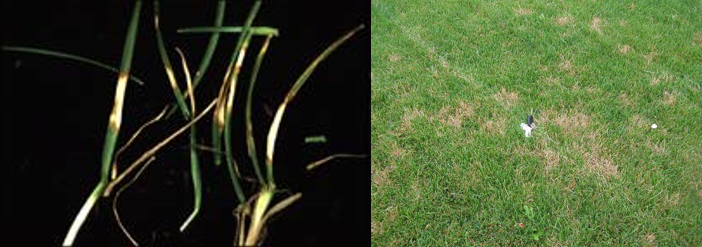
Dollar spot is most active July through August each year. Temperatures between 60 and 85 degrees and long periods of leaf wetness from dew, rain, or sprinkler irrigation favor the growth of this disease. Prolonged wet foliage is a key factor to this disease. However if conditions are favorable, activity can start early in June and continue into September. Activity can become widespread very quickly within a few days, and spots sometimes coalesce forming larger areas of bleached turf several feet in diameter. However, injury to established turf is almost never permanent.
Grass plants grow off the affected portions of the leaves allowing the disease to be mowed away. However, because dollar spot occurs in the summer when turf growth is slow, this can take weeks. Deep, infrequent watering occurring between 12am and 6am every third or fourth day is the best course of action. Underground irrigation systems should be run 1 – 1 ½ hours per zone, while hose-end sprinklers should be run 3-4 hours per zone. It is important to avoid frequent, light irrigation as this only promotes further spreading of the disease.
Maintaining an adequate nitrogen fertility in the soil is also important when treating dollar spot. Dollar spot disease favors lawns with low nitrogen, so applying a regular fertilizer throughout the season helps increase the nitrogen in the soil and reduce dollar spot activity.
Keep the grass cut high 3 – 3 ½ inches and take off 1/3 of the grass blade at a time while mowing.
Core Aerate regularly to reduce the thatch layer and reduce soil compaction. Keep the thatch layer at 1/2 inch in thickness. Further, core aeration immediately improves water and nutrient flow deeper into the soil, as well as promotes root growth for a healthier, more stress tolerant plant.
Apply a fungicide. A fungicide is meant to stop the further spreading of the disease to uninfected areas of the lawn. A fungicide gives about 20-30 days of control depending on site conditions allowing the lawn some time to grow out the disease and recover without it spreading further. If the environmental conditions remain favorable after the 20-30 day period, another fungicide may need to be applied to continue control of the disease.
Conclusion
If you are in our service area, and your lawn is showing signs of summer patch or dollar spot disease, feel free to give our office a call at 908-281-7888. If you are in our service area or a current customer, Fairway Green Inc. is happy to come out and take a look.
Brown Patch Disease and Effective Treatments
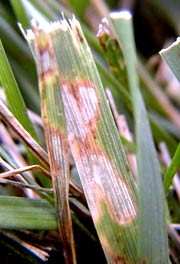
What is Brown Patch Disease?
Brown patch disease is a very destructive summer lawn disease that causes damage to lawns in the New Jersey area annually. Typically, this disease infects perennial ryegrass, tall fescue, bentgrass, and Kentucky bluegrass varieties of turf grasses. Although this disease is destructive, there are brown patch treatments that will help stop the spreading of the disease
 Signs and symptoms
Signs and symptoms
In the early morning hours when the lawn is wet from dew you will notice white spider web like structures on the surface of the turf. This is called mycelium, which is the growth of the fungus. The turf in the surrounding area will look sunken-in and have a “smoke ring” pattern. On the individual blades of grass, lesions can be seen clearly and appear as tan or light brown spots surrounded by a dark brown border, which creates the look of brown spots in your lawn during the summer.
Conditions
This disease lives in the thatch and soil, and can live there for many years even without desirable grass types to infect. Brown patch is prevalent when surface moisture and humidity are high with nighttime temperatures above 68 degrees and daytime temperatures at 80 degrees or above. Rainy weather and high humidity will accelerate the severity of this disease. This disease can form and spread almost overnight; luckily with brown patch treatments you can control the disease.
Treatment
When brown patch disease is active and the environmental conditions are favorable, spreading of the disease continues. We recommend that a fungicide be applied to the lawn for brown patch treatment; a fungicide is meant to stop the further spreading of the disease to uninfected areas of the lawn. A fungicide will give about 20-30 days of control depending on site conditions. This gives the lawn some time to grow out the disease without it spreading further and for the infected blades of the turf to recover. If the environmental conditions remain favorable after the 20-30 day period, another fungicide may need to be applied to continue control of the disease. Preventative treatments are possible but need to be applied monthly throughout the summer.
Cultural practices
The best way to prevent or reduce the spreading of brown patch disease in a lawn is to follow good cultural practices.
Water properly. Avoid light, frequent irrigation in the early morning while surface moisture is present. Deep, infrequent watering that occurs between 12 am – 6 am is the best way to water a lawn properly. Underground irrigation systems should be run 1 – 1 ½ hours per zone every third or fourth day and hose-end sprinklers should be run 3 – 4 hours per zone once per week. The goal is to get 1 inch of water on the lawn per week regardless of what type of watering application is used.
Proper mowing. Do not mow in the early morning when the lawn is still wet from dew or watering because this spreads the disease further. Mow the lawn when the surface moisture has evaporated. Keep the lawn height at 3 – 3 ½ inches in length. Mow off only the top third of the grass plant at a time. Mowing lower than the recommended height increases stress on the plant and can increase the severity of the disease. Also, we recommend removing the grass clippings after mowing until the disease is grown out, because this will help reduce further spreading. Rinse off lawn equipment after each use and keep your mower blades sharp. Dull mower blades can rip or shred the grass blades which will cause the grass to weaken and be more susceptible to disease.
Regular fertilization. Having a regular fertilization program will help the grass be strong and healthy. During the summer months it is best to avoid high amounts of nitrogen. Small amounts of nitrogen are okay in the summer to help regulate color and growth of the lawn.
Core aeration. Reduce the thatch layer and soil compaction by having the lawn core aerated regularly, at a minimum of every other year. Thatch (where disease harbors) is a loose organic layer of dead and living shoots, stems and roots that develop between the root zone of the grass blades and the soil surface. Ideally, this layer should be no more than 1/2 inch in thickness. Excessive thatch can be removed mechanically by core aeration or dethatching. The core aeration process has other benefits as well, such as providing a deeper, stronger root system and better movement of water, air and nutrients into the soil.
Conclusion
Brown patch disease can be very destructive if left unchecked. Being vigilant with good cultural practices helps to prevent or reduce the effects of this disease on your lawn. If all else fails a fungicide should be applied to defend your lawn until the environmental conditions improve. With the brown patch treatments described above, the spreading of the disease can be lessened or controlled.
If you have brown patch in your lawn and are in our service area, feel free to contact us at 908-281-7888 or visit our website at www.fairwaygreeninc.com for a free estimate to go over potential brown patch treatments.
Lawn Rust Disease
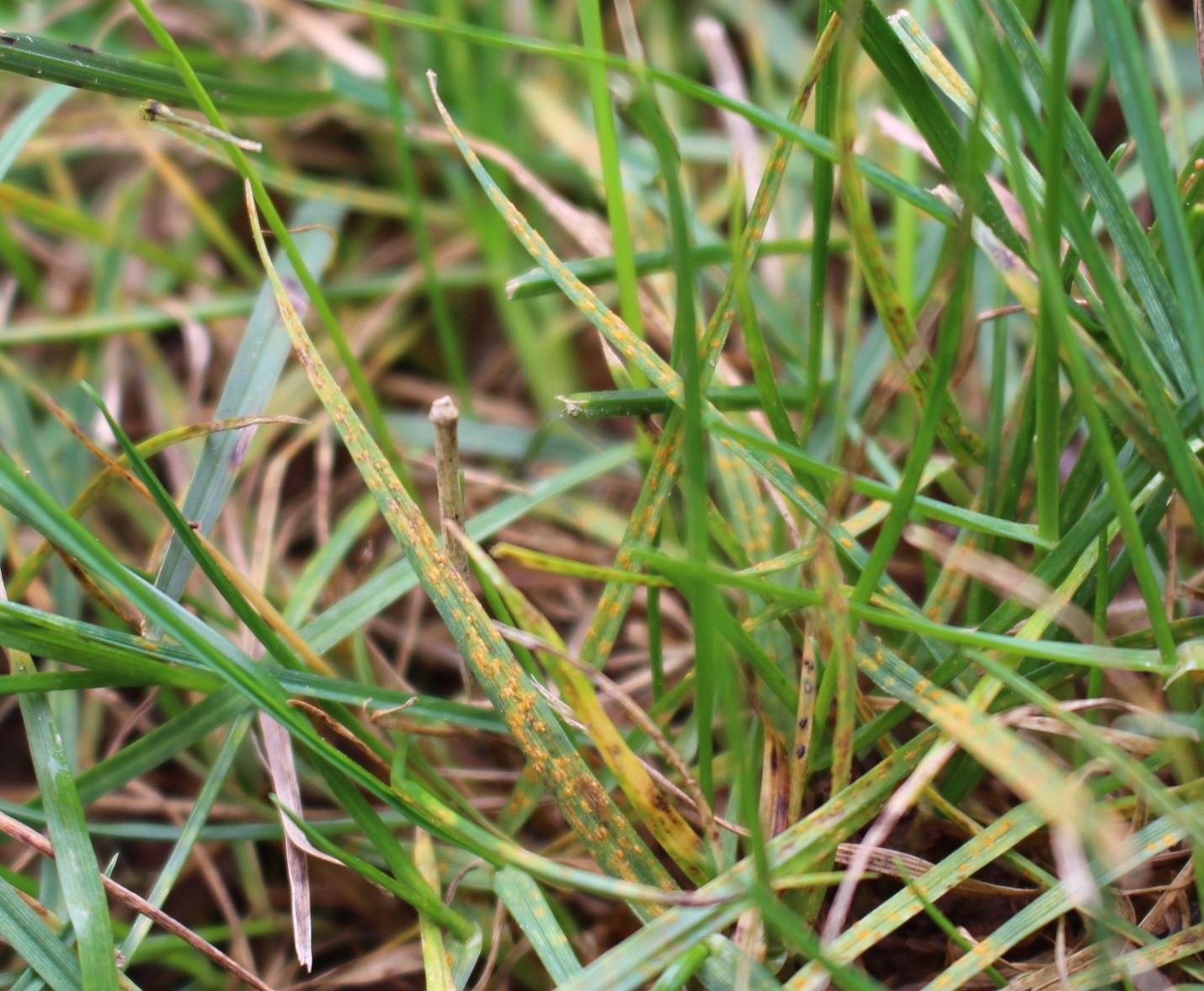
What is Lawn Rust Disease?
Lawn rust disease is a very common and harmless foliar fungus that develops on areas of turf that are slow growing. This disease can be found from mid-summer into the cooler months of the fall.
What does Lawn Rust Disease look like?
Lawn rust disease will turn areas of turf yellow-orange in color. Upon closer inspection there can be pustules along the surface of the grass blades. The spores of this fungus often rub off in a powder form leaving an orange residue on sneakers, equipment and other various objects that come in contact with the infected turf areas. Every once in a while, we get a customer that calls and asks why their dog’s feet are orange in color. The answer is simple, the spores from the rust fungus comes off easily and attach to the dog’s feet.
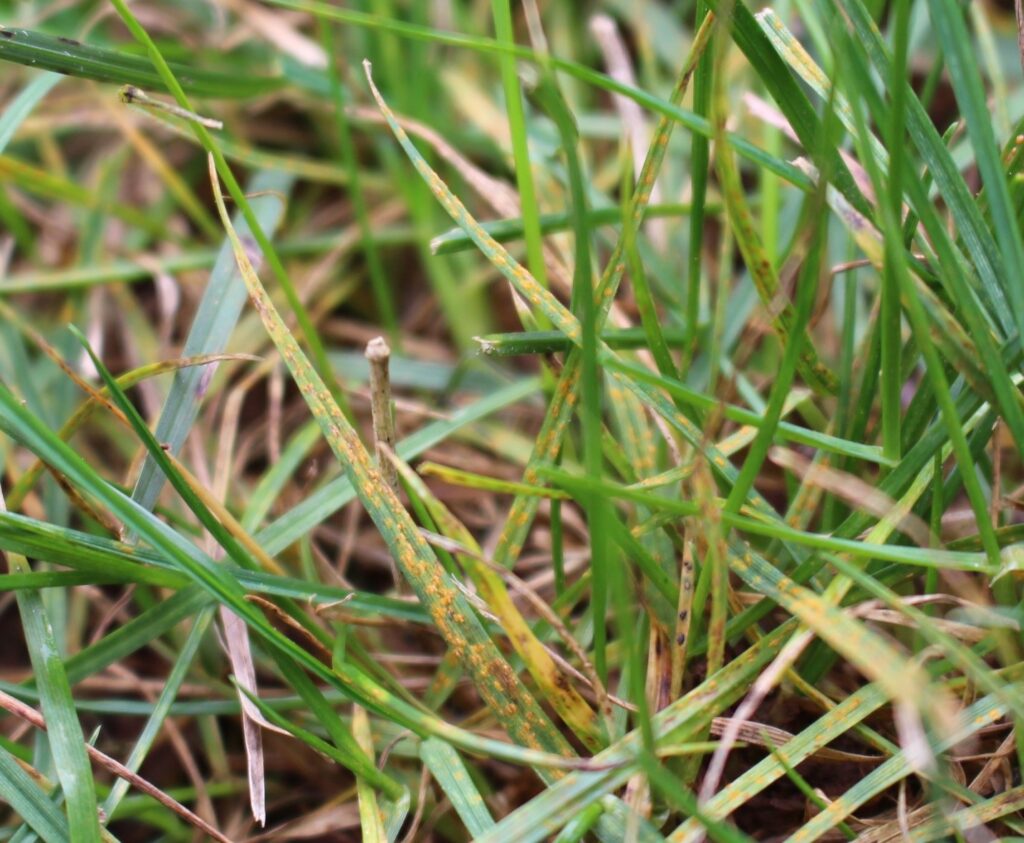
Will Lawn Rust Disease harm my lawn?
Lawn rust is a cosmetic disease that will NOT cause permanent damage to your lawn. In most cases it will grow out on its own. However, your lawn may have poor growth in the infected areas because the leaf blades are covered with spores which block sunlight from reaching the plant. This affects photosynthesis and the production of necessary carbohydrates that the plant needs to grow and be healthy. Recovery time varies on site conditions and cultural practices. The bottom line is don’t worry!
Why did my lawn get Lawn Rust Disease?
Lawn rust will often first occur in shaded or protected areas that have poor air circulation, such as under trees or at the base or behind permanent structure’s. Lawn rust commonly develops during cool nights with heavy dew and light, frequent rainfall. Warm, cloudy, humid conditions followed by hot, sunny weather will also favor rust development. Turf that has been weakened by summer heat, drought stress, low fertility, excessive thatch and shade, and soil compaction will be most susceptible to lawn rust disease. It can be spread by air, water, shoes, and equipment. Kentucky bluegrass, perennial ryegrass, and tall fescue can all be affected.
What can I do to help my lawn?
There are several things you can do to help your lawn with lawn rust disease.
- Water deeply and infrequently to stimulate growth. To start, water your lawn 1 hour per zone twice per week when using underground irrigation systems. If you’re using hose-end sprinklers, water 2 hours per zone twice per week. If these times do not improve the color or growth of the lawn you should add more time to your watering schedule. Increase the time by ½ hour increments. Water your lawn between midnight and 6 A.M. Avoid early evening watering as this increases the length of time grass blades remain wet. Many types of fungus, including lawn rust disease, requires the turf to be wet for a prolonged period of time to infect grass blades.
- Mow the lawn frequently at the proper height, 3-3 ½ inches in length and take 1/3 of the grass blade off at a time. Mowing below the recommended height will aid in depleting the grass of its energy reserves, it will also thin the lawn’s canopy and encourage weed growth. After mowing, wash off your equipment to help prevent the further spread of the disease the next time you mow.
- Reduce the thatch layer and soil compaction by having the lawn core aerated regularly, at a minimum of every other year. Thatch is a loose organic layer of dead and living shoots, stems and roots that develop between the root zone of the grass blades and the soil surface. Ideally, this layer should be no more than 1/2 inch in thickness. When thatch becomes excessive, the roots of grass plants tend to grow into the thatch layer rather than into the soil. When the thatch layer dries out due to drought or lack of moisture, the root system becomes stressed. Excessive thatch can be removed mechanically by core aeration or dethatching. The core aeration process has other benefits as well, such as also providing better movement of water, air and nutrients into the soil.
- Seed the lawn with disease resistant grass varieties to reduce susceptibility. These grass types/varieties should be selected based on site conditions.
- Fertilize your lawn regularly to help stimulate growth of the grass plants and minimize disease activity. This disease favors slow growing turf. Fertilizer will aid in growth, recovery and the overall health of your turf.
- In areas of heavy shade we recommend thinning the canopy of the trees to allow direct sunlight to reach the soil and improve air flow.
Should a fungicide be applied?
Fungicides can control many of the common diseases like lawn rust. A fungicide treatment will stop the spreading of a disease for a designated period of time. Fungicides will not replace good cultural practices that reduce stress to your lawn. The effectiveness of a fungicide depends on the correct diagnosis of the problem and proper timing of the applications. Fungicides need to be applied before the disease shows up or at the very first sign of disease activity. In most cases lawn rust disease does not reach levels that will damage a lawn before the grass can grow it out naturally. Therefore, fungicides are not usually needed for this disease.
Conclusion
Nothing beats good cultural practices. Proper watering, mowing, core aerating and fertilizing your lawn on a regular basis can beat this disease before it even starts. If your lawn shows signs of lawn rust disease or you think you may have it, give our office a call. If you are in our service area or a current customer, Fairway Green Inc. will be happy to come out and take a look.



